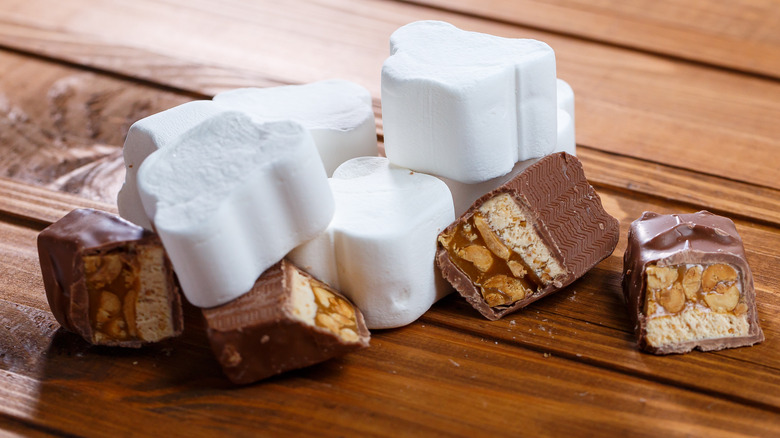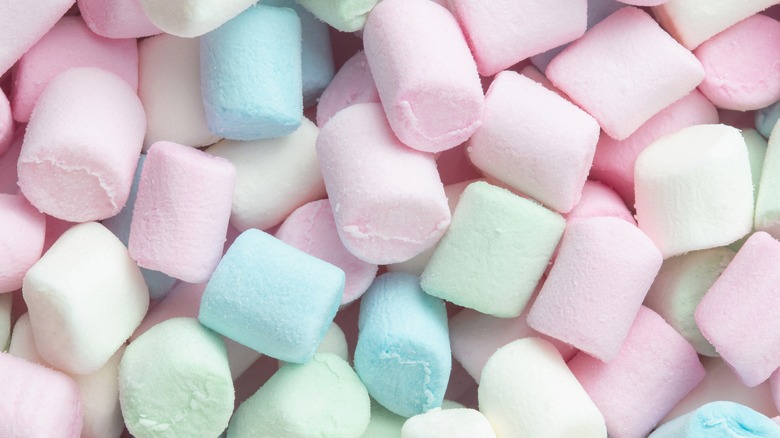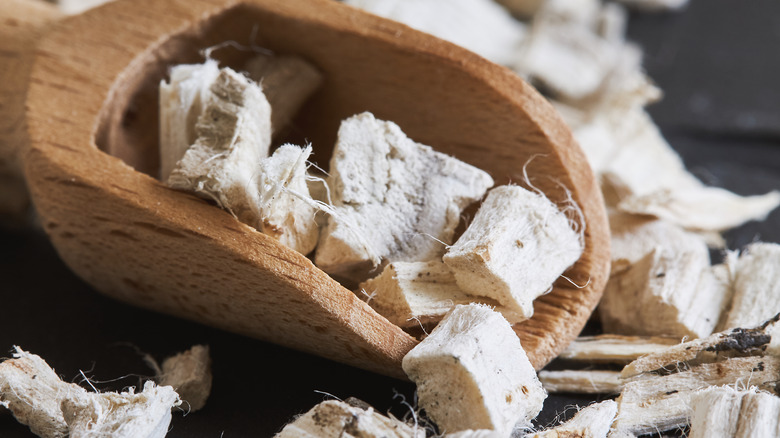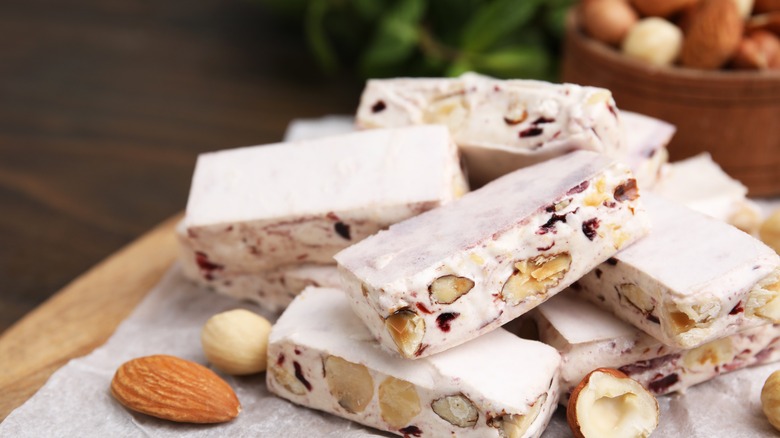What's The Difference Between Nougat And Marshmallow?
If you're a candy connoisseur, you've likely enjoyed quite a bit of marshmallow and nougat layered between crunchy wafers, coated in chocolate, stuffed inside a PB&J, or studded with dried fruit and nuts. Both of these sweet, pillowy confections have been popular among children and adults alike for hundreds of years. Before universally beloved chocolate became readily available to the masses, people satisfied their sweet tooth with these sugary treats whipped to airy perfection.
Though they share similarities in composition and texture, marshmallow and nougat are two distinct sweet treats. Their ancient origins indicate they were invented separately before evolving in different ways around the world. They're also used for different culinary purposes. Nougat is often included in prepared foods, like Snickers bars, while marshmallows are usually marketed as an ingredient for homemade recipes like Rice Krispies treats and s'mores. However, both have been enjoyed for centuries and still appear in a wide variety of candy and baked goods today.
What is marshmallow?
Modern marshmallows may be tender little pillows of sugar and gelatin, but the oldest marshmallow recipe was very different. As it turns out, marshmallow is also the name of a medicinal mallow plant native to Europe, Asia, and parts of North Africa. For thousands of years, it's been used as a remedy for coughs, sore throats, and soothing insect bites. Though many ancient communities used marshmallow root as medicine, it's believed the Egyptians were among the first to blend it with honey and nuts, creating the first marshmallows.
When whipped together with honey, the extract from marshmallow root acts as a thickener to create a tender, spongy confection. Variations of this recipe endured for thousands of years, both to treat various ailments and as a treat in and of itself. It was even marketed as a pleasant-tasting medicine in France as late as the mid-19th century.
However, as marshmallows became increasingly popular, confectioners sought ways to make production cheaper and less time-consuming. Actual marshmallow extract was replaced with gelatin, though the name stuck, and honey was replaced with sweeteners like sugar or corn syrup. Today, they have no discernible medicinal qualities, but making a batch of marshmallows may be a quick way to lift your spirits after a bad day.
What is nougat?
Like marshmallows, nougat also has its origins in the ancient world. It seems that humans have always had an insatiable sweet tooth and were constantly on the lookout for new ways to indulge it. The earliest versions of nougat likely originated in Egypt, and called for whipped honey mixed with nuts and sesame seeds. Though there's some debate as to whether this early recipe could be called nougat at all, as some believe it was the inspiration for later recipes that more closely resemble modern nougat.
Nougat or not, this ancient confection took the classical world by storm. It swept through the Mediterranean and Middle East, becoming a favorite treat from Greece to Spain. Each culture put its own spin on the recipe, adding different blends of local spices, nuts, and dried fruits. The Romans may have been the first to add whipped egg whites as a stabilizer and leavener, creating the ancestor to torrone, a classic Italian nougat enjoyed at Christmas. This more modern recipe remained popular for hundreds of years, with nougat even being served at Abraham Lincoln's inauguration dinner in 1865, alongside dozens of other foods also considered exotic at the time.
Today, many different kinds of nougat exist, from traditional torrone still produced in Italy to the layer of ultra-sweet pillowy goodness inside a Milky Way. Though specialty confectioners may still exclusively use honey in their nougat, many modern recipes use a combination of sugar and honey or sugar alone since it's cheaper and easier to source.
Delicious differences — where marshmallow and nougat diverge
When it comes to the original recipes for marshmallow and nougat, the biggest difference is that one is thickened with marshmallow root and the other is thickened with whipped, cooked honey. Marshmallows were also originally used as medicine, while it appears nougat was invented as nothing more than a confection to be enjoyed.
Nougat and marshmallows also differ in terms of their modern recipes. Modern nougat recipes are comparable to their ancient formulas, while marshmallows have diverged quite a bit from their origins. Many modern nougat recipes include honey, egg whites, nuts, seeds, and dried fruit, just like recipes found throughout ancient Europe. On the other hand, today's marshmallows no longer contain any of the original ingredients. Instead of honey, marshmallow root, and nuts, modern marshmallow recipes only require sugar, gelatin, and added flavorings like vanilla.
Marshmallows are also more common as an ingredient for other recipes, rather than a treat in and of themselves. While you can certainly eat marshmallows directly from the bag (no judgement, they're delicious), many people buy them to include in things like hot chocolate and sweet potato casserole rather than to enjoy on their own. Conversely, in the United States, nougat is rarely sold by itself outside of specialty candy shops that import it from Europe or make it in-house. Otherwise, people know it best as the mysterious, chewy layer inside their favorite chocolate bar.
Sharing the sweetness — how marshmallow and nougat overlap
Despite their differences, the original recipes for marshmallows and nougat consisted of a blend of honey and nuts whipped into a chewy consistency. Both were also popular treats throughout the ancient world, being highly valued by the cultures that made them.
In fact, both sweets were so beloved that they managed to survive into modern times, even if they look and taste somewhat different from earlier recipes. The 19th-century version of marshmallows even contained whipped egg whites, just like nougat. The egg whites helped stiffen the marshmallows so they could be shaped into lozenges and marketed as sweet medicine.
Today, neither confection features much nutritional or medicinal value, though both still taste delicious. Modern commercial versions use sugar for sweetness instead of honey, making them cheaper to produce and more accessible to the greater population. Whipped corn syrup is also often used to help give these candies their signature chewy texture.




